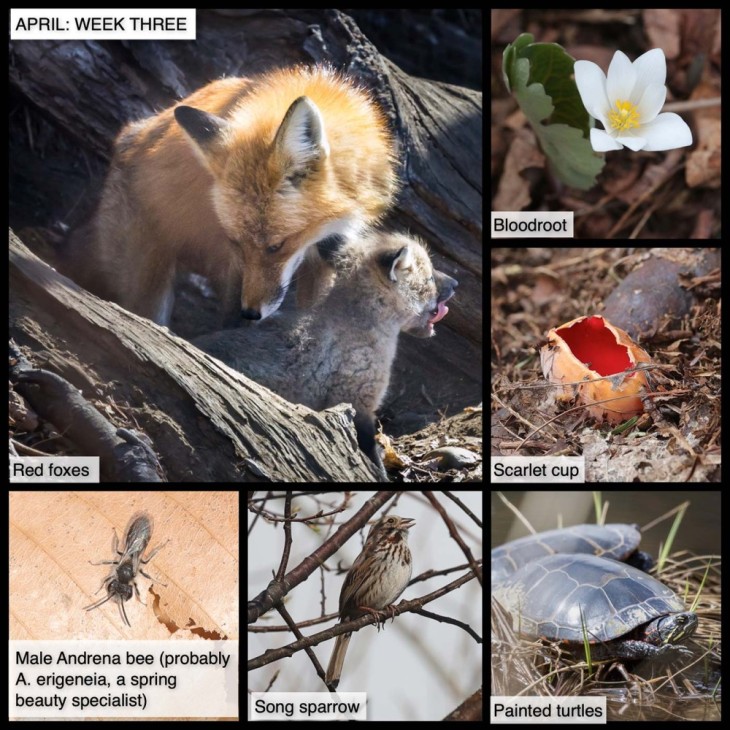This Week in the Woods, some red fox kits are venturing out of the den. As Meghan McCarthy McPhaul notes in this Outside Story essay, fox breeding pairs “generally stay together after mating, through the birth of kits … until late summer, when the family unit disperses.” As we observed at this den, the parent foxes may cache prey that they can’t immediately consume near the den, and later retrieve it to share with the kits – although in this case, the kits were still nursing, and it wasn’t clear that they were eating any meat, versus just carrying it around. Like most youngsters, they’re very playful, and sometimes test their luck with Mom by climbing all over her. Thanks to Anthea Lavallee, executive director at the Hubbard Brook Research Foundation, who located this den.
Here are some other nature sights from this week (clockwise):
Bloodroot is blooming. It seems a little unfair that such a spectacularly beautiful spring ephemeral should have such an off-putting name. As noted in this profile from the Lady Bird Johnson Wildflower Center, the name derives from the reddish juice in its roots and stem. Here’s an Outside Story essay by Howard Krum, who explains how bloodroot and some other spring ephemerals essentially bribe ants to carry their seeds back to their nests, using elaiosomes. “These structures, packed with ant-edible lipids, proteins, carbohydrates and vitamins, are also laced with oleic acid – a pheromone that is present in insect corpses and has been shown to attract carnivorous ants.” Which sounds like a fair deal, right? The plant wins because it gets to spread its seeds, and the ant wins because it gets a nutritious snack…? Maybe not. Read the essay for more, and beware gift-bearing plants.
We were excited to find scarlet cup this week. This eye-catching cup species is one of the first soft-bodied fungi to emerge in spring, and as Timothy Baroni notes in Mushrooms of the Northeastern United States and Canada, scarlet cups often arrive “just before the morels start to appear, or at the same time.”
Painted turtles are back on logs and mudflats, basking in the sun. As noted in this Outside Story essay by Susan Shea, painted turtles have “deciduous scutes.” Scutes are the bony scales that cover a turtle’s shell. “As the turtle grows, old scutes peel off, creating a thin, smooth, lightweight shell that helps this aquatic turtle swim,” Shea explains. Also check out this Community Voices interview with Lisabeth Willey, a conservation biologist who works to monitor and protect native turtles species.
It’s wonderful to hear the spring chorus starting up again, and song sparrows are doing their part. We’ve been seeing them frequently, rummaging around in meadows’ winter-flattened grass, and perched on trees at the edges of fields. As this profile from Audubon notes, males only protect small territories, “so high densities … may be present in good habitat.” Which explains why we found so many of them in a weedy (and seedy) field.
Finally – we couldn’t identify this tiny black bee and posted its photo to bugguide.net. It’s a male Andrena bee, and probably Andrena erigeneia. This solitary mining bee exclusively collects the pollen of spring beauty, an early-appearing wildflower (see a photo of the flower in last week’s post). As noted in this species profile by entomologist Michael Raupp, the female bee digs larval chambers in the soil and fills them with spring beauty “pollen cakes.” On each cake, she lays a single egg. The young will emerge as adults next spring. Raupp notes that the female bees have a relatively relaxed schedule, adapted to spring weather and spring beauty’s most bountiful pollen hours. Busy as a bee for this species means “work days from 10 ’til 12” and “rainy days off.” As for the little guy in the photo, he was basking on a leaf by a flower, presumably waiting for a female to come by – a solitary bee trying not to be solitary.
Our thanks to The Bailey Charitable Foundation and the Frank and Brinna Sands Foundation for helping to support this series.
In this difficult period, many of us find joy in observing local nature. This series, launched in April 2020, shares nature photographs taken in the past seven days, or in the same week in 2020, most within 15 miles of the Northern Woodlands office in Lyme, New Hampshire. We hope you enjoy using this grid as a prompt for your own explorations.
What are you seeing in the woods this week? Share your images with us on Facebook, or submit a special photo for possible inclusion in our monthly online Reader Photo Gallery.


